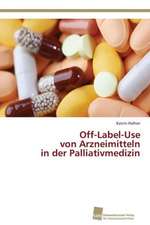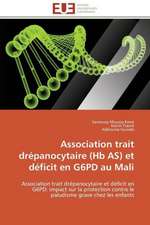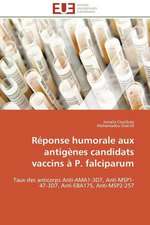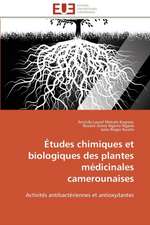Biochemistry: An Organic Chemistry Approach
Autor Michael B. Smithen Limba Engleză Paperback – 14 mai 2020
-Professor Philip Page, Emeritus Professor, School of Chemistry University of East Anglia, UK
“Introduces the key concepts of organic chemistry in a succinct and clear way”.
-Andre Cobb, KCL, UK
Reactions in biochemistry can be explained by an understanding of fundamental organic chemistry principles and reactions. This paradigm is extended to biochemical principles and to myriad biomolecules.
Biochemistry: An Organic Chemistry Approach provides a framework for understanding various topics of biochemistry, including the chemical behavior of biomolecules, enzyme activity, and more. It goes beyond mere memorization. Using several techniques to develop a relational understanding, including homework, this text helps students fully grasp and better correlate the essential organic chemistry concepts with those concepts at the root of biochemistry. The goal is to better understand the fundamental principles of biochemistry.
Features:
- Presents a review chapter of fundamental organic chemistry principles and reactions.
- Presents and explains the fundamental principles of biochemistry using principles and common reactions of organic chemistry.
- Discusses enzymes, proteins, fatty acids, lipids, vitamins, hormones, nucleic acids and other biomolecules by comparing and contrasting them with the organic chemistry reactions that constitute the foundation of these classes of biomolecules.
- Discusses the organic synthesis and reactions of amino acids, carbohydrates, nucleic acids and other biomolecules.
| Toate formatele și edițiile | Preț | Express |
|---|---|---|
| Paperback (1) | 916.01 lei 6-8 săpt. | |
| CRC Press – 14 mai 2020 | 916.01 lei 6-8 săpt. | |
| Hardback (1) | 1615.07 lei 6-8 săpt. | |
| CRC Press – 14 mai 2020 | 1615.07 lei 6-8 săpt. |
Preț: 916.01 lei
Preț vechi: 964.22 lei
-5% Nou
Puncte Express: 1374
Preț estimativ în valută:
175.30€ • 182.34$ • 144.72£
175.30€ • 182.34$ • 144.72£
Carte tipărită la comandă
Livrare economică 14-28 aprilie
Preluare comenzi: 021 569.72.76
Specificații
ISBN-13: 9780815366454
ISBN-10: 0815366450
Pagini: 398
Ilustrații: 1000
Dimensiuni: 178 x 254 x 21 mm
Greutate: 0.69 kg
Ediția:1
Editura: CRC Press
Colecția CRC Press
ISBN-10: 0815366450
Pagini: 398
Ilustrații: 1000
Dimensiuni: 178 x 254 x 21 mm
Greutate: 0.69 kg
Ediția:1
Editura: CRC Press
Colecția CRC Press
Cuprins
Contents
Preface...............................................................................................................................................xi
Author............................................................................................................................................. xiii
Common Abbreviations....................................................................................................................xv
Chapter 1 Fundamental Principles of Organic Chemistry............................................................1
1.1 Bonding and Orbitals.........................................................................................1
1.2 Ionic versus Covalent Chemical Bonds..............................................................2
1.3 Breaking Covalent Bonds...................................................................................3
1.4 Polarized Covalent σ-Bonds...............................................................................4
1.5 Reactive Intermediates.......................................................................................5
1.6 Alkanes and Isomers..........................................................................................7
1.7 The IUPAC Rules of Nomenclature...................................................................8
1.8 Rings Made of Carbon: Cyclic Compounds..................................................... 11
1.9 Hydrocarbon Functional Groups...................................................................... 11
1.10 Heteroatom Functional Groups........................................................................ 13
1.10.1 C—X Type Functional Groups........................................................... 13
1.10.2 C=X Type Functional Groups............................................................. 17
1.11 Hydrogen-Bonding and Solubility.................................................................... 21
1.12 Rotamers and Conformation............................................................................24
1.13 Conformations with Functional Groups...........................................................30
1.14 Conformation of Cyclic Molecules.................................................................. 31
1.15 Stereogenic Carbons and Stereoisomers.......................................................... 37
1.16 Absolute Configuration [(R) and (S) Nomenclature]........................................ 39
1.17 Specific Rotation..............................................................................................44
1.18 Diastereomers...................................................................................................46
1.19 Alkene Stereoisomers: (E) and (Z)-Isomers..................................................... 51
Homework...................................................................................................................54
Chapter 2 The Importance of Water in Biochemical Systems..................................................... 55
2.1 Hydrogen Bonding............................................................................................ 55
2.2 Solubility.......................................................................................................... 58
2.3 Water Molecules in Biological Systems........................................................... 59
2.4 Acid-Base Equilibria in Water......................................................................... 61
2.5 Buffers..............................................................................................................65
2.6 Structural Features That Influence Acid Strength............................................66
2.7 Acid and Base Character of Alcohols, Thiols, Amines and Carbonyls........... 67
2.7.1 Acids.................................................................................................... 67
2.7.2 Bases....................................................................................................69
2.8 Elimination Reactions of Alkyl Halides (E2 and E1 Reactions)..................... 71
2.9 Acid-Base Equilibria in Amino Acids............................................................. 74
2.10 Directionality.................................................................................................... 78
Homework...................................................................................................................80
Chapter 3 Nucleophiles and Electrophiles...................................................................................83
3.1 Nucleophiles and Bimolecular Substitution (the SN2 Reaction).......................83
3.2 Nucleophilic Substitution with Alcohols, Ethers, Amines, or Phosphines......85
3.3 Carbocations and the SN1 Reaction..................................................................88
3.4 Ethers and Thioethers as Nucleophiles............................................................90
3.5 Chemical Reactions of Carbonyl Groups.........................................................93
3.6 Biochemical Reactions of Ketones and Aldehydes..........................................96
3.7 Carboxylic Acid Derivatives and Acyl Substitution.........................................97
3.8 Biological Hydrolysis...................................................................................... 102
Homework................................................................................................................. 106
Chapter 4 Radicals..................................................................................................................... 109
4.1 Structure of Radicals...................................................................................... 109
4.2 Formation of Radicals in Organic Chemistry................................................ 110
4.3 Reactions of Radicals..................................................................................... 111
4.4 Formation of Radicals in Biological Systems................................................ 112
4.5 Radicals in Biological Systems...................................................................... 114
4.6 Radical Reactions in Biochemical Systems................................................... 116
4.7 Radicals and Cancer....................................................................................... 118
Homework................................................................................................................. 119
Chapter 5 Dienes and Conjugated Carbonyl Compounds in Biochemistry............................... 121
5.1 Conjugated Dienes and Conjugated Carbonyl Compounds........................... 121
5.2 Reactions of Conjugated Compounds............................................................124
5.3 Conjugate (Michael) Addition........................................................................ 127
5.4 Enzyme-Mediated Conjugate Additions........................................................ 128
5.5 Sigmatropic Rearrangement Reactions.......................................................... 129
5.6 Enzyme-Mediated Sigmatropic Rearrangements........................................... 132
Homework................................................................................................................. 133
Chapter 6 Enolates and Enolate Anions.................................................................................... 135
6.1 Aldehydes and Ketones Are Weak Acids....................................................... 135
6.2 Formation of Enolate Anions......................................................................... 136
6.3 The Aldol Condensation................................................................................. 137
6.4 Enzyme-Mediated Aldol Condensations........................................................ 138
6.5 The Claisen Condensation.............................................................................. 141
6.6 Enzyme-Mediated Claisen Condensation...................................................... 142
6.7 Decarboxylation............................................................................................. 143
Homework................................................................................................................. 144
Chapter 7 Enzymes.................................................................................................................... 147
7.1 Enzyme Kinetics............................................................................................ 147
7.1.1 Kinetics in Organic Chemistry......................................................... 147
7.1.2 Catalysts and Catalytic Reactions..................................................... 149
7.1.3 Enzyme Kinetics............................................................................... 149
7.2 Enzymes and Enzyme Classes....................................................................... 153
7.3 Oxidoreductases (EC 1).................................................................................. 157
7.3.1 Chemical Oxidation of Alcohols....................................................... 157
7.3.2 Oxidases............................................................................................ 159
7.3.3 Chemical Reduction of Carbonyl Compounds.................................. 161
7.3.4 Reductases......................................................................................... 162
7.4 Transferases (EC 2)........................................................................................ 163
7.4.1 Chemical Reactions That Incorporate Methyl, Hydroxyl,
Glycosyl or Amino Groups into New Molecules.............................. 163
7.4.2 Methyl, Hydroxyl, Thiol, and Glycosyl Transferases........................ 166
7.5 Hydrolyases (EC 3)......................................................................................... 168
7.5.1 Chemical Hydrolysis......................................................................... 169
7.5.2 Esterases............................................................................................ 170
7.5.3 Other Hydrolyases............................................................................. 171
7.6 Lyases (EC 4)................................................................................................. 174
7.6.1 Bond Cleavage in Organic Chemistry............................................... 174
7.6.1.1 Decarboxylation................................................................. 174
7.6.1.2 Enol Formation and the Acid-Catalyzed Aldol................. 175
7.6.1.3 Dehydration Reactions....................................................... 176
7.6.1.4 [2+2]-Photocycloaddition................................................... 177
7.6.2 Lyase Reactions................................................................................. 178
7.7 Isomerases (EC 5).......................................................................................... 180
7.7.1 Chemical Isomerization Reactions.................................................... 181
7.7.2 Isomerase Reactions.......................................................................... 184
7.8 Ligases (EC 6)................................................................................................ 185
7.8.1 Chemical Methods for Carboxylation and Nucleotide Synthesis..... 185
7.8.1.1 Reactions with Carbon Dioxide......................................... 185
7.8.1.2 Synthesis of Polynucleotides and Polynucleosides............ 186
7.8.2 Enzymatic Coupling.......................................................................... 187
7.9 Translocases (EC 7)........................................................................................ 189
7.9.1 Enzymatic Transport Reactions........................................................ 189
7.9.2 Transport of Organic Materials......................................................... 189
Homework................................................................................................................. 190
Chapter 8 Lipids......................................................................................................................... 193
8.1 Carboxylic Acids and Esters.......................................................................... 193
8.2 Nitrate Esters, Sulfate Esters, and Phosphate Esters...................................... 196
8.3 Lipid Classes.................................................................................................. 199
8.4 Chemical Synthesis of Esters.........................................................................203
8.5 Biosynthesis and Biodegradation of Esters....................................................205
Homework.................................................................................................................209
Chapter 9 Aromatic Compounds and Heterocyclic Compounds............................................... 211
9.1 Benzene and Aromaticity............................................................................... 211
9.2 Benzene Is a Carcinogen................................................................................ 213
9.3 Functionalized Benzene Derivatives.............................................................. 214
9.4 Electrophilic Aromatic Substitution: The SEAr Reaction.............................. 216
9.5 Enzymatic SEAr Reactions............................................................................. 219
9.6 Reduction of Aromatic Compounds...............................................................222
9.7 Biological Reduction of Aromatic Rings.......................................................224
9.8 Nucleophilic Aromatic Substitution. The SNAr Reaction..............................225
9.9 Enzymatic SNAr Reactions.............................................................................226
9.10 Polynuclear Aromatic Hydrocarbons.............................................................227
9.11 Heteroaromatic Compounds: Nitrogen, Oxygen, or Sulfur............................230
9.12 Reactions of Heteroaromatic Compounds...................................................... 233
9.13 Enzymatic Reactions That Generate Heterocyclic Compounds....................234
9.14 Reduced Forms of Nitrogen, Oxygen, and Sulfur Heterocycles....................238
9.15 Heteroaromatic Compounds with More Than One Ring............................... 239
Homework.................................................................................................................240
Chapter 10 Carbon–Metal Bonds, Chelating Agents and Coordination Complexes................... 243
10.1 Organometallics............................................................................................. 243
10.2 Organometallics in Organic Chemistry......................................................... 243
10.3 Biologically Relevant Metals..........................................................................246
10.4 Chelating Agents............................................................................................248
Homework................................................................................................................. 251
Chapter 11 Amino Acids............................................................................................................. 253
11.1 Characteristics of Amino Acids..................................................................... 253
11.2 Structure of α-Amino Acids........................................................................... 255
Homework................................................................................................................. 259
Chapter 12 Peptides and Proteins................................................................................................ 261
12.1 Reactions and Synthesis of α-Amino Acids................................................... 261
12.2 Amino Acid Biosynthesis............................................................................... 267
12.3 Peptides Are Poly(amides) of Amino Acid Residues.....................................268
12.4 Chemical Synthesis of Peptides...................................................................... 274
12.5 Peptide Biosynthesis.......................................................................................277
12.6 Proteins and Enzymes Are Poly(peptides).....................................................280
12.7 Peptide Degradation and End Group Identification.......................................280
12.8 Peptidases.......................................................................................................284
Homework.................................................................................................................285
Chapter 13 Carbohydrates...........................................................................................................287
13.1 (Poly)hydroxy Carbonyl Compounds.............................................................287
13.2 Monosaccharides............................................................................................288
13.3 Mutarotation...................................................................................................293
13.4 The Anomeric Effect......................................................................................294
13.5 Ketose Monosaccharides................................................................................295
Homework.................................................................................................................297
Chapter 14 Glycosides.................................................................................................................299
14.1 Monosaccharides............................................................................................299
14.2 Disaccharides, Trisaccharides, Oligosaccharides, and Polysaccharides........300
14.3 Reactions of Carbohydrates............................................................................ 301
14.4 Biologically Important Glycosides.................................................................305
14.5 Biosynthesis of Carbohydrates and Glycosides..............................................308
14.6 Biodegradation of Carbohydrates and Glycosides......................................... 313
Homework................................................................................................................. 316
Chapter 15 Nucleic Acids, Nucleosides and Nucleotides............................................................ 317
15.1 Nucleosides and Nucleotides.......................................................................... 317
15.2 Polynucleotides............................................................................................... 320
15.3 Chemical Synthesis of Nucleotides................................................................ 325
15.4 Biosynthesis of Nucleotides............................................................................ 328
15.5 Ribozymes...................................................................................................... 330
15.6 Hydrolysis of RNA and DNA......................................................................... 332
15.7 RNA-Mediated Programmable DNA Cleavage............................................. 333
15.8 Restriction Enzymes....................................................................................... 334
Homework................................................................................................................. 336
Chapter 16 Answers to Homework Problems.............................................................................. 337
Chapter 1................................................................................................................... 337
Chapter 2................................................................................................................... 338
Chapter 3................................................................................................................... 339
Chapter 4................................................................................................................... 341
Chapter 5................................................................................................................... 343
Chapter 6...................................................................................................................344
Chapter 7................................................................................................................... 345
Chapter 8...................................................................................................................349
Chapter 9................................................................................................................... 350
Chapter 10................................................................................................................. 352
Chapter 11................................................................................................................. 353
Chapter 12................................................................................................................. 354
Chapter 13................................................................................................................. 356
Chapter 14................................................................................................................. 358
Chapter 15................................................................................................................. 361
Index............................................................................................................................................... 363
Preface...............................................................................................................................................xi
Author............................................................................................................................................. xiii
Common Abbreviations....................................................................................................................xv
Chapter 1 Fundamental Principles of Organic Chemistry............................................................1
1.1 Bonding and Orbitals.........................................................................................1
1.2 Ionic versus Covalent Chemical Bonds..............................................................2
1.3 Breaking Covalent Bonds...................................................................................3
1.4 Polarized Covalent σ-Bonds...............................................................................4
1.5 Reactive Intermediates.......................................................................................5
1.6 Alkanes and Isomers..........................................................................................7
1.7 The IUPAC Rules of Nomenclature...................................................................8
1.8 Rings Made of Carbon: Cyclic Compounds..................................................... 11
1.9 Hydrocarbon Functional Groups...................................................................... 11
1.10 Heteroatom Functional Groups........................................................................ 13
1.10.1 C—X Type Functional Groups........................................................... 13
1.10.2 C=X Type Functional Groups............................................................. 17
1.11 Hydrogen-Bonding and Solubility.................................................................... 21
1.12 Rotamers and Conformation............................................................................24
1.13 Conformations with Functional Groups...........................................................30
1.14 Conformation of Cyclic Molecules.................................................................. 31
1.15 Stereogenic Carbons and Stereoisomers.......................................................... 37
1.16 Absolute Configuration [(R) and (S) Nomenclature]........................................ 39
1.17 Specific Rotation..............................................................................................44
1.18 Diastereomers...................................................................................................46
1.19 Alkene Stereoisomers: (E) and (Z)-Isomers..................................................... 51
Homework...................................................................................................................54
Chapter 2 The Importance of Water in Biochemical Systems..................................................... 55
2.1 Hydrogen Bonding............................................................................................ 55
2.2 Solubility.......................................................................................................... 58
2.3 Water Molecules in Biological Systems........................................................... 59
2.4 Acid-Base Equilibria in Water......................................................................... 61
2.5 Buffers..............................................................................................................65
2.6 Structural Features That Influence Acid Strength............................................66
2.7 Acid and Base Character of Alcohols, Thiols, Amines and Carbonyls........... 67
2.7.1 Acids.................................................................................................... 67
2.7.2 Bases....................................................................................................69
2.8 Elimination Reactions of Alkyl Halides (E2 and E1 Reactions)..................... 71
2.9 Acid-Base Equilibria in Amino Acids............................................................. 74
2.10 Directionality.................................................................................................... 78
Homework...................................................................................................................80
Chapter 3 Nucleophiles and Electrophiles...................................................................................83
3.1 Nucleophiles and Bimolecular Substitution (the SN2 Reaction).......................83
3.2 Nucleophilic Substitution with Alcohols, Ethers, Amines, or Phosphines......85
3.3 Carbocations and the SN1 Reaction..................................................................88
3.4 Ethers and Thioethers as Nucleophiles............................................................90
3.5 Chemical Reactions of Carbonyl Groups.........................................................93
3.6 Biochemical Reactions of Ketones and Aldehydes..........................................96
3.7 Carboxylic Acid Derivatives and Acyl Substitution.........................................97
3.8 Biological Hydrolysis...................................................................................... 102
Homework................................................................................................................. 106
Chapter 4 Radicals..................................................................................................................... 109
4.1 Structure of Radicals...................................................................................... 109
4.2 Formation of Radicals in Organic Chemistry................................................ 110
4.3 Reactions of Radicals..................................................................................... 111
4.4 Formation of Radicals in Biological Systems................................................ 112
4.5 Radicals in Biological Systems...................................................................... 114
4.6 Radical Reactions in Biochemical Systems................................................... 116
4.7 Radicals and Cancer....................................................................................... 118
Homework................................................................................................................. 119
Chapter 5 Dienes and Conjugated Carbonyl Compounds in Biochemistry............................... 121
5.1 Conjugated Dienes and Conjugated Carbonyl Compounds........................... 121
5.2 Reactions of Conjugated Compounds............................................................124
5.3 Conjugate (Michael) Addition........................................................................ 127
5.4 Enzyme-Mediated Conjugate Additions........................................................ 128
5.5 Sigmatropic Rearrangement Reactions.......................................................... 129
5.6 Enzyme-Mediated Sigmatropic Rearrangements........................................... 132
Homework................................................................................................................. 133
Chapter 6 Enolates and Enolate Anions.................................................................................... 135
6.1 Aldehydes and Ketones Are Weak Acids....................................................... 135
6.2 Formation of Enolate Anions......................................................................... 136
6.3 The Aldol Condensation................................................................................. 137
6.4 Enzyme-Mediated Aldol Condensations........................................................ 138
6.5 The Claisen Condensation.............................................................................. 141
6.6 Enzyme-Mediated Claisen Condensation...................................................... 142
6.7 Decarboxylation............................................................................................. 143
Homework................................................................................................................. 144
Chapter 7 Enzymes.................................................................................................................... 147
7.1 Enzyme Kinetics............................................................................................ 147
7.1.1 Kinetics in Organic Chemistry......................................................... 147
7.1.2 Catalysts and Catalytic Reactions..................................................... 149
7.1.3 Enzyme Kinetics............................................................................... 149
7.2 Enzymes and Enzyme Classes....................................................................... 153
7.3 Oxidoreductases (EC 1).................................................................................. 157
7.3.1 Chemical Oxidation of Alcohols....................................................... 157
7.3.2 Oxidases............................................................................................ 159
7.3.3 Chemical Reduction of Carbonyl Compounds.................................. 161
7.3.4 Reductases......................................................................................... 162
7.4 Transferases (EC 2)........................................................................................ 163
7.4.1 Chemical Reactions That Incorporate Methyl, Hydroxyl,
Glycosyl or Amino Groups into New Molecules.............................. 163
7.4.2 Methyl, Hydroxyl, Thiol, and Glycosyl Transferases........................ 166
7.5 Hydrolyases (EC 3)......................................................................................... 168
7.5.1 Chemical Hydrolysis......................................................................... 169
7.5.2 Esterases............................................................................................ 170
7.5.3 Other Hydrolyases............................................................................. 171
7.6 Lyases (EC 4)................................................................................................. 174
7.6.1 Bond Cleavage in Organic Chemistry............................................... 174
7.6.1.1 Decarboxylation................................................................. 174
7.6.1.2 Enol Formation and the Acid-Catalyzed Aldol................. 175
7.6.1.3 Dehydration Reactions....................................................... 176
7.6.1.4 [2+2]-Photocycloaddition................................................... 177
7.6.2 Lyase Reactions................................................................................. 178
7.7 Isomerases (EC 5).......................................................................................... 180
7.7.1 Chemical Isomerization Reactions.................................................... 181
7.7.2 Isomerase Reactions.......................................................................... 184
7.8 Ligases (EC 6)................................................................................................ 185
7.8.1 Chemical Methods for Carboxylation and Nucleotide Synthesis..... 185
7.8.1.1 Reactions with Carbon Dioxide......................................... 185
7.8.1.2 Synthesis of Polynucleotides and Polynucleosides............ 186
7.8.2 Enzymatic Coupling.......................................................................... 187
7.9 Translocases (EC 7)........................................................................................ 189
7.9.1 Enzymatic Transport Reactions........................................................ 189
7.9.2 Transport of Organic Materials......................................................... 189
Homework................................................................................................................. 190
Chapter 8 Lipids......................................................................................................................... 193
8.1 Carboxylic Acids and Esters.......................................................................... 193
8.2 Nitrate Esters, Sulfate Esters, and Phosphate Esters...................................... 196
8.3 Lipid Classes.................................................................................................. 199
8.4 Chemical Synthesis of Esters.........................................................................203
8.5 Biosynthesis and Biodegradation of Esters....................................................205
Homework.................................................................................................................209
Chapter 9 Aromatic Compounds and Heterocyclic Compounds............................................... 211
9.1 Benzene and Aromaticity............................................................................... 211
9.2 Benzene Is a Carcinogen................................................................................ 213
9.3 Functionalized Benzene Derivatives.............................................................. 214
9.4 Electrophilic Aromatic Substitution: The SEAr Reaction.............................. 216
9.5 Enzymatic SEAr Reactions............................................................................. 219
9.6 Reduction of Aromatic Compounds...............................................................222
9.7 Biological Reduction of Aromatic Rings.......................................................224
9.8 Nucleophilic Aromatic Substitution. The SNAr Reaction..............................225
9.9 Enzymatic SNAr Reactions.............................................................................226
9.10 Polynuclear Aromatic Hydrocarbons.............................................................227
9.11 Heteroaromatic Compounds: Nitrogen, Oxygen, or Sulfur............................230
9.12 Reactions of Heteroaromatic Compounds...................................................... 233
9.13 Enzymatic Reactions That Generate Heterocyclic Compounds....................234
9.14 Reduced Forms of Nitrogen, Oxygen, and Sulfur Heterocycles....................238
9.15 Heteroaromatic Compounds with More Than One Ring............................... 239
Homework.................................................................................................................240
Chapter 10 Carbon–Metal Bonds, Chelating Agents and Coordination Complexes................... 243
10.1 Organometallics............................................................................................. 243
10.2 Organometallics in Organic Chemistry......................................................... 243
10.3 Biologically Relevant Metals..........................................................................246
10.4 Chelating Agents............................................................................................248
Homework................................................................................................................. 251
Chapter 11 Amino Acids............................................................................................................. 253
11.1 Characteristics of Amino Acids..................................................................... 253
11.2 Structure of α-Amino Acids........................................................................... 255
Homework................................................................................................................. 259
Chapter 12 Peptides and Proteins................................................................................................ 261
12.1 Reactions and Synthesis of α-Amino Acids................................................... 261
12.2 Amino Acid Biosynthesis............................................................................... 267
12.3 Peptides Are Poly(amides) of Amino Acid Residues.....................................268
12.4 Chemical Synthesis of Peptides...................................................................... 274
12.5 Peptide Biosynthesis.......................................................................................277
12.6 Proteins and Enzymes Are Poly(peptides).....................................................280
12.7 Peptide Degradation and End Group Identification.......................................280
12.8 Peptidases.......................................................................................................284
Homework.................................................................................................................285
Chapter 13 Carbohydrates...........................................................................................................287
13.1 (Poly)hydroxy Carbonyl Compounds.............................................................287
13.2 Monosaccharides............................................................................................288
13.3 Mutarotation...................................................................................................293
13.4 The Anomeric Effect......................................................................................294
13.5 Ketose Monosaccharides................................................................................295
Homework.................................................................................................................297
Chapter 14 Glycosides.................................................................................................................299
14.1 Monosaccharides............................................................................................299
14.2 Disaccharides, Trisaccharides, Oligosaccharides, and Polysaccharides........300
14.3 Reactions of Carbohydrates............................................................................ 301
14.4 Biologically Important Glycosides.................................................................305
14.5 Biosynthesis of Carbohydrates and Glycosides..............................................308
14.6 Biodegradation of Carbohydrates and Glycosides......................................... 313
Homework................................................................................................................. 316
Chapter 15 Nucleic Acids, Nucleosides and Nucleotides............................................................ 317
15.1 Nucleosides and Nucleotides.......................................................................... 317
15.2 Polynucleotides............................................................................................... 320
15.3 Chemical Synthesis of Nucleotides................................................................ 325
15.4 Biosynthesis of Nucleotides............................................................................ 328
15.5 Ribozymes...................................................................................................... 330
15.6 Hydrolysis of RNA and DNA......................................................................... 332
15.7 RNA-Mediated Programmable DNA Cleavage............................................. 333
15.8 Restriction Enzymes....................................................................................... 334
Homework................................................................................................................. 336
Chapter 16 Answers to Homework Problems.............................................................................. 337
Chapter 1................................................................................................................... 337
Chapter 2................................................................................................................... 338
Chapter 3................................................................................................................... 339
Chapter 4................................................................................................................... 341
Chapter 5................................................................................................................... 343
Chapter 6...................................................................................................................344
Chapter 7................................................................................................................... 345
Chapter 8...................................................................................................................349
Chapter 9................................................................................................................... 350
Chapter 10................................................................................................................. 352
Chapter 11................................................................................................................. 353
Chapter 12................................................................................................................. 354
Chapter 13................................................................................................................. 356
Chapter 14................................................................................................................. 358
Chapter 15................................................................................................................. 361
Index............................................................................................................................................... 363
Notă biografică
Professor Michael B. Smith was born in Detroit, Michigan, and moved to
Madison Heights, Virginia, in 1957. He graduated from Amherst County
High School in 1964. He worked at Old Dominion Box Factory for a year
after graduation and then started college at Ferrum Jr. College in 1965. He
graduated in 1967 with an A.A. and began studies at Virginia Tech later that
year, graduating with a B.S. in Chemistry in 1969. He worked as a chemist at
the Newport News Shipbuilding & Dry Dock Co, Newport News, Virginia,
from 1969 until 1972. In 1972 he began studies in graduate school at Purdue
University in West Lafayette, Indiana, working with Prof. Joseph Wolinsky.
He graduated in 1977 with a Ph.D. in Organic Chemistry. He took a postdoctoral
position at Arizona State University in Tempe, Arizona, working on the isolation of anti-cancer
agents from marine animals with Professor Bob Pettit. After one year, he took another postdoctoral
position at MIT in Cambridge, Massachusetts, working on the synthesis of the anti-cancer drug
bleomycin with Professor Sidney Hecht.
Professor Smith began his independent career as an assistant professor in the Chemistry department
at the University of Connecticut, Storrs, Connecticut, in 1979. He received tenure in 1986, and
spent six months on sabbatical in Belgium, with Professor Leon Ghosez at the Universite Catholique
de Louvain in Louvain la Neuve, Belgium. He was promoted to full professor in 1994 and spent his
entire career at UCONN. Prof. Smith’s research involved the synthesis of biologically interesting
molecules. His most recent work involved the preparation of functionalized indocyanine dyes for
the detection of hypoxic cancerous tumors (breast cancer). Another project involved the synthesis of
inflammatory lipids derived from the dental pathogen, Porphyromonas gingivalis.
He has published 26 books, including Organic Chemistry: An Acid-Base Approach, 2nd edition
(Taylor & Francis), the 5th–8th editions of March’s Advanced Organic Chemistry (Wiley), and
Organic Synthesis, 4th edition (Elsevier), winner of a 2018 Texty Award. Prof. Smith published 96
peer-reviewed research papers and retired from UCONN in January of 2017.
Madison Heights, Virginia, in 1957. He graduated from Amherst County
High School in 1964. He worked at Old Dominion Box Factory for a year
after graduation and then started college at Ferrum Jr. College in 1965. He
graduated in 1967 with an A.A. and began studies at Virginia Tech later that
year, graduating with a B.S. in Chemistry in 1969. He worked as a chemist at
the Newport News Shipbuilding & Dry Dock Co, Newport News, Virginia,
from 1969 until 1972. In 1972 he began studies in graduate school at Purdue
University in West Lafayette, Indiana, working with Prof. Joseph Wolinsky.
He graduated in 1977 with a Ph.D. in Organic Chemistry. He took a postdoctoral
position at Arizona State University in Tempe, Arizona, working on the isolation of anti-cancer
agents from marine animals with Professor Bob Pettit. After one year, he took another postdoctoral
position at MIT in Cambridge, Massachusetts, working on the synthesis of the anti-cancer drug
bleomycin with Professor Sidney Hecht.
Professor Smith began his independent career as an assistant professor in the Chemistry department
at the University of Connecticut, Storrs, Connecticut, in 1979. He received tenure in 1986, and
spent six months on sabbatical in Belgium, with Professor Leon Ghosez at the Universite Catholique
de Louvain in Louvain la Neuve, Belgium. He was promoted to full professor in 1994 and spent his
entire career at UCONN. Prof. Smith’s research involved the synthesis of biologically interesting
molecules. His most recent work involved the preparation of functionalized indocyanine dyes for
the detection of hypoxic cancerous tumors (breast cancer). Another project involved the synthesis of
inflammatory lipids derived from the dental pathogen, Porphyromonas gingivalis.
He has published 26 books, including Organic Chemistry: An Acid-Base Approach, 2nd edition
(Taylor & Francis), the 5th–8th editions of March’s Advanced Organic Chemistry (Wiley), and
Organic Synthesis, 4th edition (Elsevier), winner of a 2018 Texty Award. Prof. Smith published 96
peer-reviewed research papers and retired from UCONN in January of 2017.
Recenzii
Describing an interesting way to teach biochemistry, especially in conjunction with organic chemistry, this textbook should find application at many schools. The first of 15 chapters is a review of the fundamentals of an organic chemistry course, but a full course may be necessary for beginners to benefit from further study. Subsequent discussion of organic reactions and mechanisms will be more meaningful for students already familiar with organic chemistry basics. Chapter 2 describes acid-base chemistry, elimination reactions, and the importance of water in chemistry. Chapter 3 discusses nucleophilic substitution; chapter 4 explains free radical reactions. Subsequent chapters discuss, respectively, dienes, conjugated systems, sigmatropic rearrangements, enols and enolate reactions, enzymes, enzyme kinetics, carboxylic acid and derivatives, lipids, aromatic chemistry, heteroaromatic chemistry, organometallic compounds, biologically relevant metals, chelating reagents, amino acids, peptides, proteins, carbohydrates and derivatives, glycosides, nucleosides, nucleotides, DNA, and RNA. Each chapter concludes with homework questions; finally, chapter 16 includes the answers to the questions. Common abbreviations are listed at the beginning of the book, and several compounds and functional groups also have line formulas or partial structures shown. The book can be used by teachers and students of chemistry, and will be useful for all chemists as a review.
--R. E. Buntrock, independent scholar
Summing Up: Recommended. Lower- and upper-division undergraduates. Graduate students, faculty, and professionals.
--R. E. Buntrock, independent scholar
Summing Up: Recommended. Lower- and upper-division undergraduates. Graduate students, faculty, and professionals.
Descriere
Organic Chemistry and Biochemical Applications provides a framework for understanding various topics of organic chemistry, as well as the behavior of biomolecules, enzyme activity, and more.

